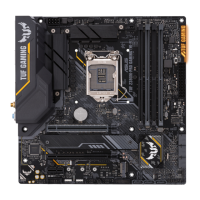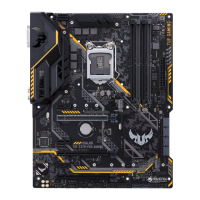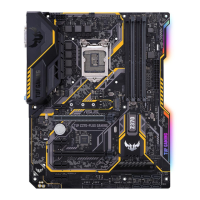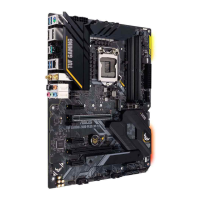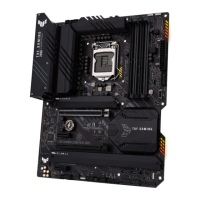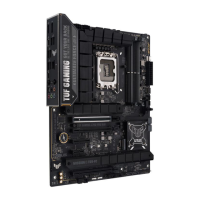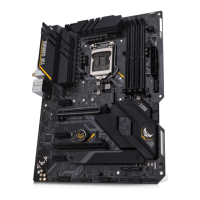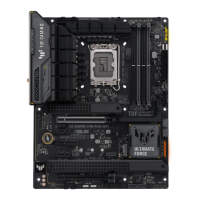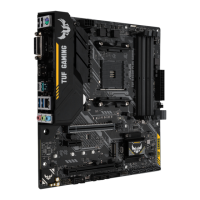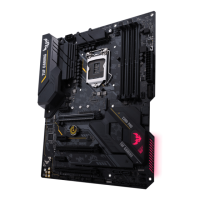
Do you have a question about the Asus TUF Z390-PRO GAMING and is the answer not in the manual?
| Non-ECC | Yes |
|---|---|
| Memory channels | Dual-channel |
| Memory slots type | DIMM |
| Number of memory slots | 4 |
| Supported memory types | DDR4-SDRAM |
| Maximum internal memory | 64 GB |
| Supported memory clock speeds | 2133, 2400, 2666, 2800, 3000, 3200, 3300, 3333, 3400, 3466, 3600, 3733, 3866, 4000, 4133, 4266 MHz |
| Intel® Turbo Boost Technology | 3.0 |
| Processor socket | LGA 1151 (Socket H4) |
| Processor manufacturer | Intel |
| Compatible processor series | Intel Celeron, Intel Pentium |
| Component for | PC |
| Motherboard chipset | Intel Z390 |
| Audio output channels | 7.1 channels |
| Motherboard form factor | ATX |
| Windows operating systems supported | Windows 10 |
| Graphics card | UHD Graphics |
| Maximum resolution | 4096 x 2160 pixels |
| Parallel processing technology support | 2-Way SLI, CrossFireX |
| Number of M.2 (M) slots | 2 |
| PCI Express x1 (Gen 3.x) slots | 3 |
| Number of SATA II connectors | 0 |
| Number of SATA III connectors | 6 |
| Number of EATX power connectors | 1 |
| RAID levels | 0, 1, 5, 10 |
| LAN controller | Intel® I219-V |
| BIOS type | UEFI AMI |
| ACPI version | 6.1 |
| BIOS memory size | 16 Mbit |
| USB 2.0 ports quantity | USB 2.0 ports have a data transmission speed of 480 Mbps, and are backwards compatible with USB 1.1 ports. You can connect all kinds of peripheral devices to them. |
| Depth | 244 mm |
|---|---|
| Width | 305 mm |
Guidelines for preventing electrical shock hazards when handling system components.
Precautions for safe installation and operation of the motherboard and components.
Ensuring the correct CPU for the LGA1151 socket is installed to prevent damage.
Precautions for handling the CPU, including protecting the socket and retaining the PnP cap.
Diagram showing the four DDR4 DIMM slots on the motherboard.
Illustrations and guidelines for installing memory modules in dual-channel configurations.
Details on the MemOK! II switch for memory re-training and troubleshooting boot failures.
Instructions on how to use the Clear RTC RAM jumper to reset CMOS settings.
Description of Q LEDs (BOOT, VGA, DRAM, CPU) for identifying boot process errors.
Guidelines for connecting ATX power supply plugs to the motherboard.
General guidance for PC system building with reference diagrams for motherboard layout.
Step-by-step instructions for safely installing the CPU into the LGA1151 socket.
Guidance on applying thermal interface material to the CPU and cooling system.
Steps for correctly mounting the CPU heatsink and fan assembly onto the motherboard.
Instructions for connecting the All-In-One cooler pump and fans to motherboard headers.
Steps for placing the motherboard into the chassis and securing it with screws.
Step-by-step guide for inserting DIMM modules into the motherboard slots.
Instructions on how to properly remove installed DIMM modules from the slots.
Ensuring the 8-pin or 8-pin and 4-pin ATX power plugs are correctly connected.
Illustrations showing how to connect SATA data and power cables to hard disk drives.
Steps for inserting expansion cards into PCIe x16 and PCIe x1 slots.
Step-by-step guide for installing M.2 SSD modules into the M.2_2 socket.
Diagram and list of all rear panel connectors including USB, LAN, HDMI, DisplayPort, and audio.
Steps for connecting power, turning on devices, and running Power-On Self Test (POST).
Table explaining BIOS beep codes for diagnosing hardware issues during startup.
Introduction to the UEFI BIOS interface, its features, and basic functions.
Situations requiring BIOS configuration or updates, such as error messages or new components.
Methods to enter BIOS Setup by pressing specific keys during the Power-On Self Test (POST).
Alternative methods to access BIOS Setup by using system reset or power cycling.
Description of EZ Mode's functions for system information, language, performance, and boot priority.
Explanation of the Advanced Mode layout, including menu bar, configuration fields, and hot keys.
Choosing specific fans (CPU, Chassis, AIO Pump) to configure their operating speed.
Options to apply pre-set fan profiles or manually set PWM/DC control modes.
Steps to adjust fan speed curves by dragging speed points in the manual configuration.
Options for configuring overclocking-related items, with caution for incorrect values.
Adjusting Base Clock frequency and enabling ASUS MultiCore Enhancement for performance.
Configuring CPU core ratios and memory operating frequencies for optimization.
Details on CPU-related information, power management, Intel SpeedStep, Turbo Mode, and C-States.
Setting boot options, including Fast Boot, Next Boot after AC Power Loss, and Setup Mode.
Utility for updating the motherboard BIOS using a USB flash drive.
Introduction to utilities for managing and updating the motherboard BIOS.
Using the EZ Update utility to update the BIOS within the Windows environment.
Step-by-step guide to updating the BIOS using ASUS EZ Flash 3 with a USB drive.
Instructions for updating BIOS using EZ Flash 3 through an internet connection.
Using CrashFree BIOS 3 to restore a corrupted BIOS file from a USB flash drive.

